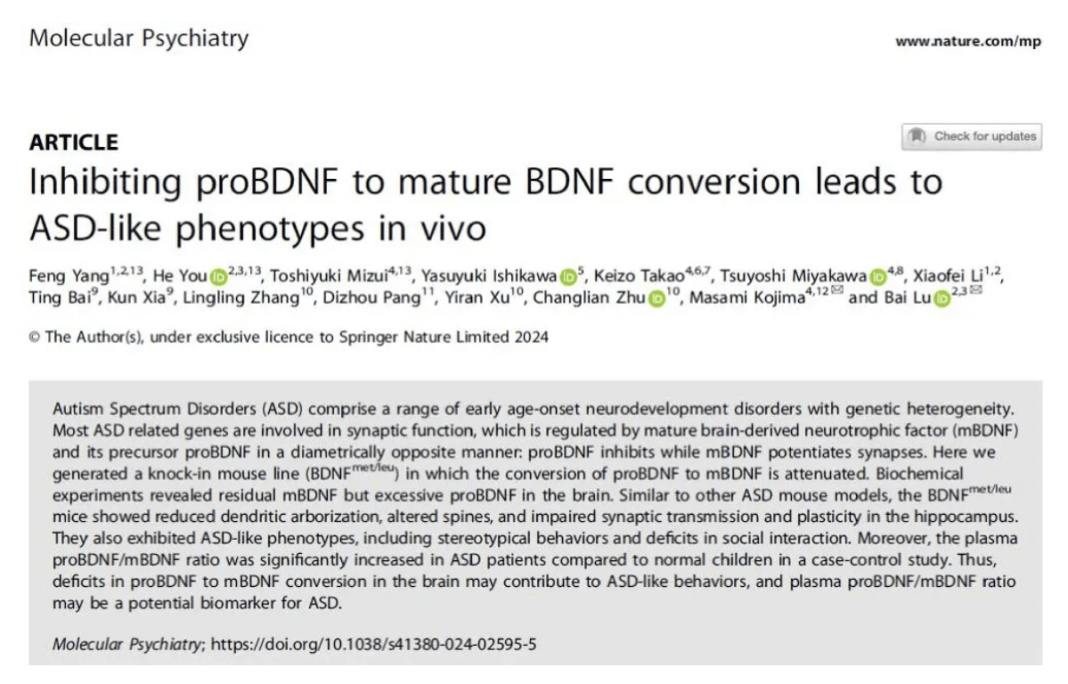Autism spectrum disorder (ASD) arises from a complex interplay of genetic and environmental factors causing brain developmental abnormalities, with its core manifestation being structural and functional abnormalities of brain synaptic connections. The precursor protein proBDNF and the cleaved mature protein mBDNF of brain-derived neurotrophic factor (BDNF) play distinct roles in negative (resulting in cell death and synaptic atrophy) and positive (promoting cell survival and synaptic enhancement) effects, respectively, being crucial in neural synapse development.
Based on the “BDNF Yin-Yang Theory,” the Lu Bai team artificially increased proBDNF and lowered mBDNF in the brain by simulating proBDNF cleavage hindrance, creating a successful ASD mouse model. This model exhibits synaptic damage and behavioral defects similar to human ASD.
Further research revealed that the ratio of proBDNF to mBDNF in the blood plasma of ASD children is also abnormally elevated, indicating issues in the process of proBDNF to mBDNF conversion inside the brain. This finding opens new pathways for ASD biomarker research, holding significant importance in disease progression monitoring and drug efficacy assessment.
Background
Autism spectrum disorder (ASD) is an early-onset neurodevelopmental disorder characterized by three core behaviors: difficulty in social interaction, impaired language communication abilities, and repetitive and stereotyped behaviors. Epidemiological studies show that the global prevalence of ASD has surged to 1%, posing a serious threat to children’s physical and mental health. Without early intervention, it could lead to lifelong disabilities, significantly impacting various aspects of their lives. Effective medications for treating ASD are currently unavailable.
Genetic studies suggest that mutations in certain genes can lead to ASD. However, the majority of ASD patients do not have clear genetic causes or a significant family history of the disorder. Mutated genes associated with ASD include those found in Fragile X syndrome, Phelan-McDermid syndrome, and Angelman syndrome. These genetic mutations affecting synaptic structure and function are common features in ASD. Not only genetic factors but also environmental influences are believed to play a role in ASD development, increasing the risk of ASD by affecting synaptic development and function.
Research Findings
Recently, the Lu Bai team from Tsinghua University, in collaboration with the Yang Feng team from Beijing Tiantan Hospital affiliated with Capital Medical University and the Kojima team from Kanazawa Institute of Technology in Japan, published a study in Molecular Psychiatry titled “Inhibiting proBDNF to mature BDNF conversion leads to autism-like phenotypes in vivo.” This study highlighted the core pathological role of BDNF enzymatic cleavage hindrance in causing synaptic structural and functional abnormalities in the pathogenesis of ASD, resulting in the creation of a new ASD animal model—BDNFmet/leu mice.
Content of the Study
Professor Lu Bai proposed the Yin-Yang Theory of BDNF, explaining that proBDNF induces cell death and synaptic atrophy, whereas mBDNF promotes cell survival and synaptic enhancement. By altering the amino acids of the cleavage site in collaboration with the Kojima team, they inhibited proBDNF cleavage, leading to a significant increase in proBDNF and a decrease in mBDNF in the brain. The BDNFmet/leu mouse model constructed based on this principle exhibited synaptic damage, social behavior defects, repetitive behavior, and stereotyped behavior similar to human ASD patients.
Comparison with previous models showed that the BDNFmet/leu mice demonstrated pathological phenotypes closely associated with ASD, including decreased complexity of neuronal dendritic trees, increased immature dendritic spines, decreased mature dendritic spines, changes in synaptic proteins, reduced synaptic transmission, and impaired long-term potentiation (LTP) and long-term depression (LTD). These phenotypes, rare in previous models, suggest that alterations in the proBDNF and mBDNF protein ratio leading to systemic synaptic damage may be a key factor in ASD pathogenesis rather than Bdnf gene mutations.
Conclusion of the Study
In conclusion, the study explored the phenomenon of hindered proBDNF cleavage resulting in a significant increase in proBDNF and marked decrease in mBDNF in the brain, proposing a new mechanism for the pathogenesis of ASD. This research not only provides a new perspective on synaptic lesions causing ASD based on protein modifications rather than gene mutations but also offers a potential biomarker for monitoring disease progression and evaluating drug efficacy. It is believed that this study will advance precise ASD treatment strategies and open new paths for medical research in the field of ASD.


